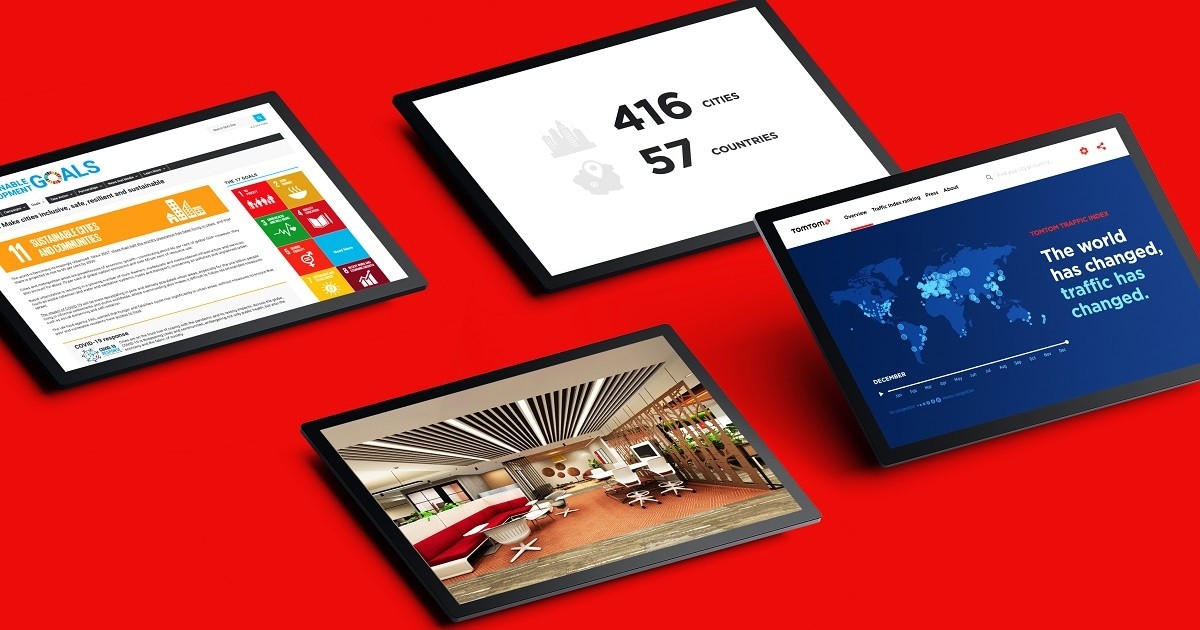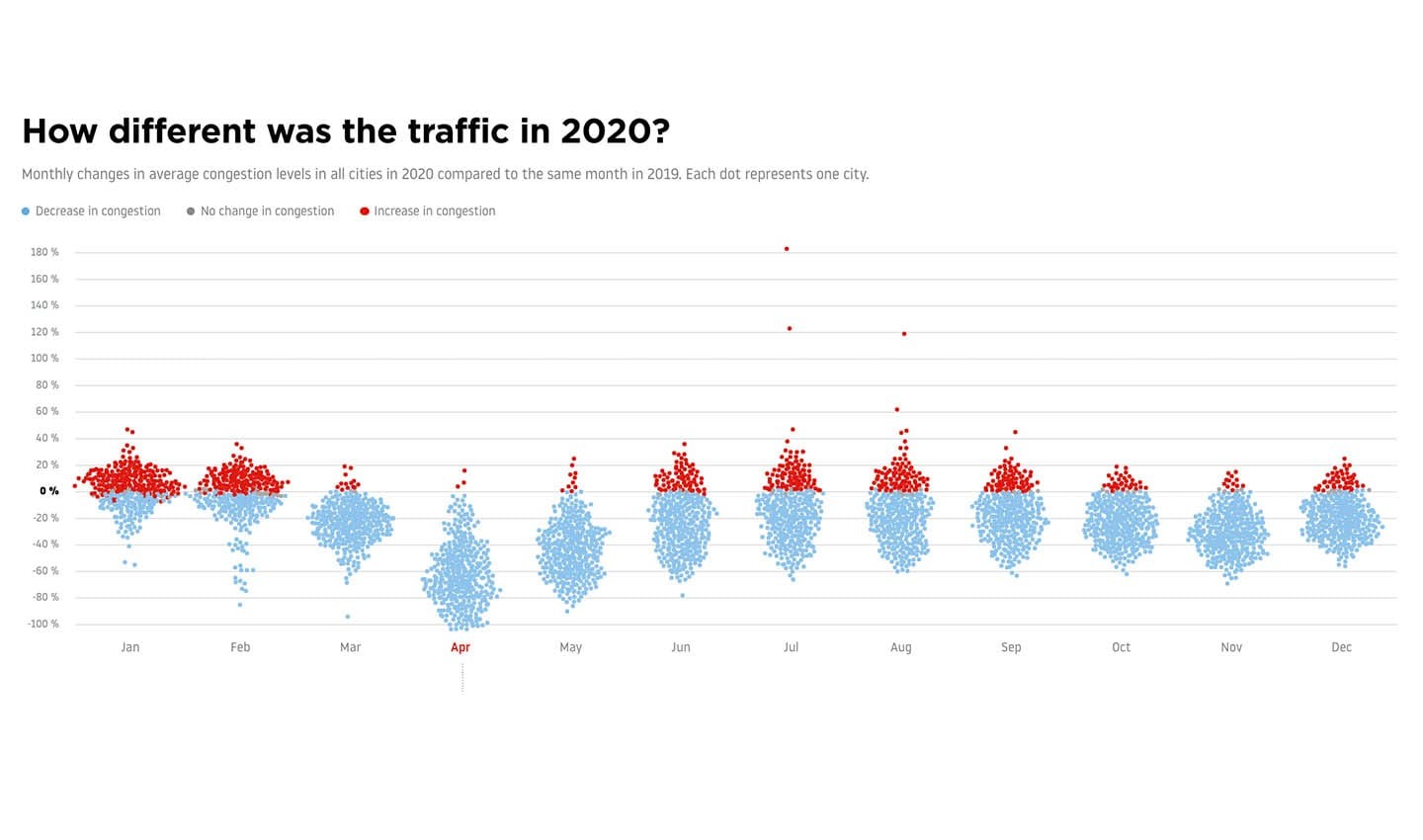What your 2021 commute could mean for the environment, as told by TomTom Traffic Index data
&w=256&q=90)

In 2020, traffic levels underwent significant change. From this, we can ask ourselves a question – how could this change inform our decision-making in 2021? We can find the answer to that by first looking at the data. Enter our Traffic Index.
The TomTom Traffic Index is a report that TomTom publishes every year, revealing traffic congestion levels in cities around the world. With data pulled from over 600 million connected devices, the Index is intended to help everyone evaluate the time they spend on the road, skipping some traffic jams in the process.
But as we’ve already established, 2020’s data is different. It leads us to reflect on how we haven’t used the road, with urban congestion dropping unlike anything we’ve seen in the last 10 years. We can see the extent of this in the graph below.
 In April, we observed a substantial drop in traffic congestion in cities around the world. Some cities even had as much as 30 days with low traffic – where congestion levels were at least 50% lower than the same day in 2019.
In April, we observed a substantial drop in traffic congestion in cities around the world. Some cities even had as much as 30 days with low traffic – where congestion levels were at least 50% lower than the same day in 2019.This data tells us what happened. What’s important is how it can have an impact on us going forward, which leads us to the environment. Nicholas Cohn, Senior Product Manager, reveals that by reducing congestion, “we can improve the air quality, which is good for the health of our cities everywhere.”. Now, the question is, how can we continue this progress once full mobility is back on the table in 2021? To help, the United Nations gives us a target for urban sustainability.
SDG 11 and sustainable development
Sustainable Development Goal 11 (or SDG 11) is a long-term goal set out by the United Nations (UN), and put into practice by governments, businesses, civil society and citizens. It aims to make ‘cities and human settlements inclusive, safe, resilient and sustainable.’ To turn this goal into a reality, we’re proud to leverage our Traffic Index data, to encourage organizations, policymakers and drivers to reduce urban congestion.
2021 offers the chance to succeed in this. We’ve already seen some impact in Amsterdam. This year, the city is using our data to see how congestion is affected when one of the main roads coming into the city is shut. As traffic within the Netherlands has already been affected by 2020’s events, we can see how collaborations in 2021 might help us sustain this change, fulfilling our goals of reducing congestion, improving air quality, yet keeping everything accessible.
We see SDG 11 as the UN’s Bat Signal for urban environments – it's a call to all of us to start taking charge of how we travel, being more mindful of congestion and the choices that bring us closer to a more sustainable world. This includes how we work, which as we’ve seen from our data, had a huge impact on congestion levels in 2020. In line with that, we’ve reimagined how we can approach the way we operate.
The growing importance of remote work
As a result of 2020, many of us were forced to work from home for safety reasons. However, looking beyond COVID-19, we started to consider how tech and service companies could manage an activity-based working strategy to benefit productivity and the environment. Think of it as less of a band aid and more of a long-term fix.
That long-term fix is freedom on where we work. We can actively introduce the option to work from home in 2021, depending on what we need to accomplish. This encourages us to ask ourselves whether we really need to be in the office – the commute there and back equals a lot of preventable emissions.
That’s why we’re changing the way we work with full flexibility. Inspired by feedback from TomTom’ers, it enables us to choose where we work – at home or in the office – depending on the task at hand.
We have begun renovations on our offices to make this decision easier, starting with Pune, one of our largest offices globally. As you’ll see in the images below, we’ve replaced rows of desks and chairs with collaborative spaces for team projects. But if we’re prioritizing a solo task, such as perfecting our software, we can choose home and save a commute in the process.
 This freedom suits us perfectly, as it means we can individually work more effectively, while playing our part in achieving a cleaner, congestion-free world.
This freedom suits us perfectly, as it means we can individually work more effectively, while playing our part in achieving a cleaner, congestion-free world.“Arne-Christian van der Tang
Chief Human Resources Officer, TomTom
Up for some more actionable data and insights? Take a look at our Traffic Index for insights on 2020 – hopefully you’ll feel inspired to make decisions that help keep congestion down in 2021 and beyond.
Let’s take the wheel as organizations and as people to work and adapt in a way that keeps that traffic congestion low. Why not join us in trying to make a difference?
People also read
)
How COVID-19 changed mobility: A look back from the future
)
Prioritizing a great workplace in 2020
)
What can traffic data tell us about the impact of the coronavirus?
* Required field. By submitting your contact details to TomTom, you agree that we can contact you about marketing offers, newsletters, or to invite you to webinars and events. We could further personalize the content that you receive via cookies. You can unsubscribe at any time by the link included in our emails. Review our privacy policy.